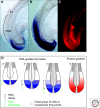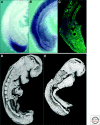Signaling gradients during paraxial mesoderm development
- PMID: 20182616
- PMCID: PMC2828275
- DOI: 10.1101/cshperspect.a000869
Signaling gradients during paraxial mesoderm development
Abstract
The sequential formation of somites along the anterior-posterior axis is under control of multiple signaling gradients involving the Wnt, FGF, and retinoic acid (RA) pathways. These pathways show graded distribution of signaling activity within the paraxial mesoderm of vertebrate embryos. Although Wnt and FGF signaling show highest activity in the posterior, unsegmented paraxial mesoderm (presomitic mesoderm [PSM]), RA signaling establishes a countergradient with the highest activity in the somites. The generation of these graded activities relies both on classical source-sink mechanisms (for RA signaling) and on an RNA decay mechanism (for FGF signaling). Numerous studies reveal the tight interconnection among Wnt, FGF, and RA signaling in controlling paraxial mesoderm differentiation and in defining the somite-forming unit. In particular, the relationship to a molecular oscillator acting in somite precursors in the PSM-called the segmentation clock-has been recently addressed. These studies indicate that high levels of Wnt and FGF signaling are required for the segmentation clock activity. Furthermore, we discuss how these signaling gradients act in a dose-dependent manner in the progenitors of the paraxial mesoderm, partly by regulating cell movements during gastrulation. Finally, links between the process of axial specification of vertebral segments and Hox gene expression are discussed.
Figures





References
-
- Arnold SJ, Stappert J, Bauer A, Kispert A, Herrmann BG, Kemler R 2000. Brachyury is a target gene of the Wnt/β-catenin signaling pathway. Mech Dev 91:249–258 - PubMed
-
- Aulehla A, Herrmann BG 2004. Segmentation in vertebrates: Clock and gradient finally joined. Genes Dev 18:2060–2067 - PubMed
-
- Aulehla A, Wehrle C, Brand-Saberi B, Kemler R, Gossler A, Kanzler B, Herrmann BG 2003. Wnt3a plays a major role in the segmentation clock controlling somitogenesis. Dev Cell 4:395–406 - PubMed
-
- Barrallo-Gimeno A, Nieto MA 2005. The Snail genes as inducers of cell movement and survival: Implications in development and cancer. Development 132:3151–3161 - PubMed
Publication types
MeSH terms
Substances
Grants and funding
LinkOut - more resources
Full Text Sources
Other Literature Sources
Miscellaneous
